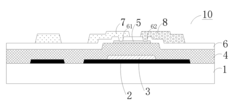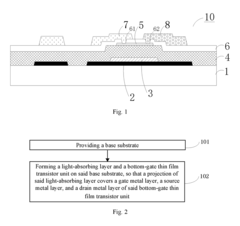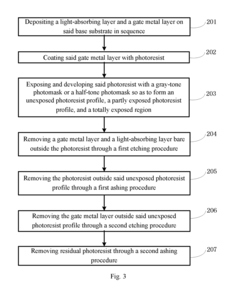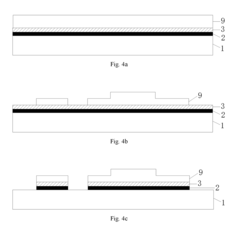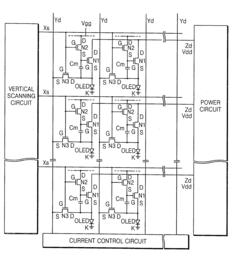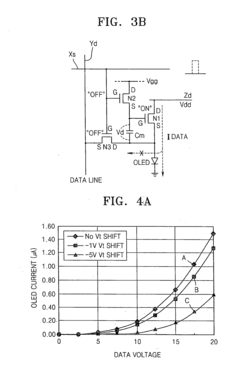Improvements in AMOLED's ambient light performance.
JUL 17, 20259 MIN READ
Generate Your Research Report Instantly with AI Agent
Patsnap Eureka helps you evaluate technical feasibility & market potential.
AMOLED Ambient Light Evolution and Objectives
AMOLED (Active-Matrix Organic Light-Emitting Diode) technology has revolutionized display systems since its inception, offering superior image quality, energy efficiency, and form factor advantages. The evolution of AMOLED's ambient light performance has been a critical focus area, driven by the increasing demand for displays that maintain visibility and color accuracy across diverse lighting conditions.
The journey of AMOLED ambient light performance began with early implementations that struggled in bright environments. Initial AMOLED displays suffered from significant reflectivity and poor sunlight readability, limiting their usability in outdoor settings. This challenge prompted intensive research and development efforts to enhance the technology's performance under varying light conditions.
As the technology progressed, several key objectives emerged to guide the improvement of AMOLED's ambient light performance. These included reducing screen reflectivity, enhancing brightness capabilities, optimizing power consumption, and maintaining color accuracy across different lighting scenarios. Achieving these objectives required advancements in materials science, panel design, and display driving techniques.
One of the primary goals in AMOLED evolution has been to minimize screen reflectivity. This involves developing anti-reflective coatings and optimizing the display stack to reduce the amount of ambient light reflected off the screen surface. By decreasing reflections, AMOLED displays can maintain better contrast and visibility in bright environments, significantly improving the user experience.
Another crucial objective has been to increase the peak brightness of AMOLED displays without compromising their energy efficiency or lifespan. Higher brightness levels allow the display to overcome ambient light interference, ensuring content remains visible even in direct sunlight. This has led to the development of more efficient OLED materials and advanced pixel architectures capable of delivering higher luminance levels.
Color accuracy under varying light conditions has also been a key focus area. AMOLED displays aim to maintain consistent color reproduction regardless of the ambient lighting environment. This objective has driven the development of advanced color management systems and adaptive display technologies that can adjust color parameters based on ambient light sensors.
The evolution of AMOLED technology has also targeted improvements in power efficiency, particularly when operating in high-brightness modes necessitated by bright ambient conditions. This objective aligns with the broader trend towards energy-efficient mobile devices and has spurred innovations in display driver ICs and power management techniques.
As AMOLED technology continues to evolve, the overarching goal remains to create displays that offer an optimal viewing experience across all lighting conditions, from dimly lit rooms to bright outdoor environments. This ongoing pursuit drives research into new materials, manufacturing processes, and display architectures, ensuring that AMOLED technology remains at the forefront of display innovation.
The journey of AMOLED ambient light performance began with early implementations that struggled in bright environments. Initial AMOLED displays suffered from significant reflectivity and poor sunlight readability, limiting their usability in outdoor settings. This challenge prompted intensive research and development efforts to enhance the technology's performance under varying light conditions.
As the technology progressed, several key objectives emerged to guide the improvement of AMOLED's ambient light performance. These included reducing screen reflectivity, enhancing brightness capabilities, optimizing power consumption, and maintaining color accuracy across different lighting scenarios. Achieving these objectives required advancements in materials science, panel design, and display driving techniques.
One of the primary goals in AMOLED evolution has been to minimize screen reflectivity. This involves developing anti-reflective coatings and optimizing the display stack to reduce the amount of ambient light reflected off the screen surface. By decreasing reflections, AMOLED displays can maintain better contrast and visibility in bright environments, significantly improving the user experience.
Another crucial objective has been to increase the peak brightness of AMOLED displays without compromising their energy efficiency or lifespan. Higher brightness levels allow the display to overcome ambient light interference, ensuring content remains visible even in direct sunlight. This has led to the development of more efficient OLED materials and advanced pixel architectures capable of delivering higher luminance levels.
Color accuracy under varying light conditions has also been a key focus area. AMOLED displays aim to maintain consistent color reproduction regardless of the ambient lighting environment. This objective has driven the development of advanced color management systems and adaptive display technologies that can adjust color parameters based on ambient light sensors.
The evolution of AMOLED technology has also targeted improvements in power efficiency, particularly when operating in high-brightness modes necessitated by bright ambient conditions. This objective aligns with the broader trend towards energy-efficient mobile devices and has spurred innovations in display driver ICs and power management techniques.
As AMOLED technology continues to evolve, the overarching goal remains to create displays that offer an optimal viewing experience across all lighting conditions, from dimly lit rooms to bright outdoor environments. This ongoing pursuit drives research into new materials, manufacturing processes, and display architectures, ensuring that AMOLED technology remains at the forefront of display innovation.
Market Demand for Enhanced Display Visibility
The demand for enhanced display visibility in AMOLED screens has been steadily increasing, driven by the growing use of mobile devices in various lighting conditions. Consumers increasingly expect their devices to perform well not only indoors but also in bright outdoor environments, where traditional displays often struggle with readability.
Market research indicates that improved ambient light performance is a key factor influencing purchasing decisions for smartphones, tablets, and wearable devices. Users frequently cite screen visibility in sunlight as a critical feature, with many expressing frustration over the inability to use their devices effectively outdoors.
The automotive industry has also emerged as a significant market for AMOLED displays with enhanced visibility. As more vehicles incorporate digital dashboards and infotainment systems, the need for screens that remain clear and legible under varying light conditions has become paramount for safety and user satisfaction.
In the professional sector, there is a growing demand for mobile devices and laptops with displays that maintain high visibility in diverse work environments. This includes outdoor worksites, brightly lit offices, and mobile workspaces where lighting conditions can change rapidly.
The wearable technology market, particularly smartwatches and fitness trackers, has shown a strong preference for displays with improved ambient light performance. Users expect to be able to check their devices quickly and easily during outdoor activities without struggling to see the screen.
Consumer electronics manufacturers have recognized this market trend and are increasingly focusing on ambient light performance as a key differentiator for their products. This has led to a competitive landscape where brands are vying to offer the best display visibility across various lighting conditions.
The demand extends beyond mere brightness improvements. Consumers are looking for displays that can automatically adjust to changing light conditions, maintain color accuracy, and reduce glare while minimizing power consumption. This complex set of requirements presents both challenges and opportunities for AMOLED technology development.
As remote work and outdoor leisure activities continue to gain popularity, the market for devices with superior display visibility is expected to expand further. This trend is likely to drive ongoing innovation in AMOLED technology, pushing manufacturers to develop more advanced solutions for ambient light performance.
Market research indicates that improved ambient light performance is a key factor influencing purchasing decisions for smartphones, tablets, and wearable devices. Users frequently cite screen visibility in sunlight as a critical feature, with many expressing frustration over the inability to use their devices effectively outdoors.
The automotive industry has also emerged as a significant market for AMOLED displays with enhanced visibility. As more vehicles incorporate digital dashboards and infotainment systems, the need for screens that remain clear and legible under varying light conditions has become paramount for safety and user satisfaction.
In the professional sector, there is a growing demand for mobile devices and laptops with displays that maintain high visibility in diverse work environments. This includes outdoor worksites, brightly lit offices, and mobile workspaces where lighting conditions can change rapidly.
The wearable technology market, particularly smartwatches and fitness trackers, has shown a strong preference for displays with improved ambient light performance. Users expect to be able to check their devices quickly and easily during outdoor activities without struggling to see the screen.
Consumer electronics manufacturers have recognized this market trend and are increasingly focusing on ambient light performance as a key differentiator for their products. This has led to a competitive landscape where brands are vying to offer the best display visibility across various lighting conditions.
The demand extends beyond mere brightness improvements. Consumers are looking for displays that can automatically adjust to changing light conditions, maintain color accuracy, and reduce glare while minimizing power consumption. This complex set of requirements presents both challenges and opportunities for AMOLED technology development.
As remote work and outdoor leisure activities continue to gain popularity, the market for devices with superior display visibility is expected to expand further. This trend is likely to drive ongoing innovation in AMOLED technology, pushing manufacturers to develop more advanced solutions for ambient light performance.
Current AMOLED Ambient Light Challenges
AMOLED displays face significant challenges in ambient light conditions, particularly in outdoor environments with high brightness. One of the primary issues is the reduced visibility and color accuracy when exposed to strong sunlight. The organic materials used in AMOLED screens are susceptible to degradation when subjected to intense light, leading to decreased longevity and potential burn-in effects.
Another challenge is the reflection of ambient light on the display surface, which can cause glare and reduce contrast. This problem is exacerbated by the fact that AMOLED displays typically have a glossy finish to enhance color vibrancy, making them more prone to reflections compared to matte-finished LCD screens.
Power consumption is also a concern in bright ambient conditions. AMOLED displays need to increase their brightness significantly to maintain visibility in sunlight, which can lead to rapid battery drain. This is particularly problematic for mobile devices that rely on AMOLED technology.
Color shift is another issue that becomes more pronounced in ambient light. AMOLED displays may exhibit changes in color temperature and saturation when viewed under different lighting conditions, affecting the overall visual experience and color accuracy of the content displayed.
The auto-brightness feature, while designed to help, can sometimes struggle to adapt quickly and accurately to rapidly changing light conditions. This can result in a suboptimal viewing experience as the display may appear too dim or too bright during transitions.
AMOLED's ambient light performance is also affected by the limited maximum brightness levels compared to some LCD technologies. While AMOLED displays excel in producing deep blacks and high contrast ratios in low-light conditions, they often fall short in achieving the peak brightness levels necessary for clear visibility in direct sunlight.
Lastly, the inherent characteristics of AMOLED technology, such as the use of organic compounds and the individual lighting of each pixel, present unique challenges in managing heat generation and dissipation. Increased brightness levels in high ambient light situations can lead to localized heating, potentially impacting the display's performance and lifespan.
Addressing these challenges requires innovative solutions in materials science, display architecture, and power management to enhance AMOLED's ambient light performance while maintaining its advantages in color reproduction and energy efficiency in normal lighting conditions.
Another challenge is the reflection of ambient light on the display surface, which can cause glare and reduce contrast. This problem is exacerbated by the fact that AMOLED displays typically have a glossy finish to enhance color vibrancy, making them more prone to reflections compared to matte-finished LCD screens.
Power consumption is also a concern in bright ambient conditions. AMOLED displays need to increase their brightness significantly to maintain visibility in sunlight, which can lead to rapid battery drain. This is particularly problematic for mobile devices that rely on AMOLED technology.
Color shift is another issue that becomes more pronounced in ambient light. AMOLED displays may exhibit changes in color temperature and saturation when viewed under different lighting conditions, affecting the overall visual experience and color accuracy of the content displayed.
The auto-brightness feature, while designed to help, can sometimes struggle to adapt quickly and accurately to rapidly changing light conditions. This can result in a suboptimal viewing experience as the display may appear too dim or too bright during transitions.
AMOLED's ambient light performance is also affected by the limited maximum brightness levels compared to some LCD technologies. While AMOLED displays excel in producing deep blacks and high contrast ratios in low-light conditions, they often fall short in achieving the peak brightness levels necessary for clear visibility in direct sunlight.
Lastly, the inherent characteristics of AMOLED technology, such as the use of organic compounds and the individual lighting of each pixel, present unique challenges in managing heat generation and dissipation. Increased brightness levels in high ambient light situations can lead to localized heating, potentially impacting the display's performance and lifespan.
Addressing these challenges requires innovative solutions in materials science, display architecture, and power management to enhance AMOLED's ambient light performance while maintaining its advantages in color reproduction and energy efficiency in normal lighting conditions.
Existing Ambient Light Performance Solutions
01 Ambient light sensing and display adjustment
AMOLED displays can be equipped with ambient light sensors to detect environmental lighting conditions. This information is used to automatically adjust display brightness and contrast, optimizing visibility and power consumption in various lighting environments. The system can also adapt color temperature and gamma settings based on ambient light for improved viewing comfort.- Ambient light sensing and display adjustment: AMOLED displays can be equipped with ambient light sensors to detect surrounding light conditions. This information is used to automatically adjust display brightness and contrast, optimizing visibility and power consumption in various lighting environments. The system can also adapt color temperature and gamma correction based on ambient light, enhancing overall display performance.
- Power efficiency in ambient light conditions: AMOLED displays can be designed to optimize power consumption based on ambient light conditions. This includes selectively activating or deactivating pixels, adjusting refresh rates, and modifying color depths. These techniques help maintain display quality while minimizing power usage, particularly in low-light environments where full brightness is not necessary.
- Enhanced readability in bright ambient light: To improve AMOLED display performance in bright ambient light conditions, various technologies can be implemented. These include anti-reflective coatings, adaptive contrast enhancement, and dynamic range expansion. These features help maintain image clarity and color accuracy even in challenging lighting environments such as direct sunlight.
- Color management in varying ambient light: AMOLED displays can incorporate advanced color management systems that adapt to changing ambient light conditions. This includes adjusting color gamut, white point, and saturation levels to maintain color accuracy and consistency across different lighting environments. Some systems also use machine learning algorithms to predict optimal color settings based on ambient light patterns.
- Integration with other sensors for improved performance: AMOLED display performance in ambient light conditions can be further enhanced by integrating data from multiple sensors. This may include proximity sensors, gyroscopes, and cameras. By combining this data, the display can more accurately adjust its settings to optimize visibility and power efficiency based on the user's environment and device orientation.
02 Power efficiency in ambient light conditions
AMOLED displays can be optimized for power efficiency in different ambient light conditions. This includes selectively activating or deactivating pixels, adjusting refresh rates, and implementing dynamic power management techniques. These methods help maintain display quality while minimizing power consumption, especially in low-light environments.Expand Specific Solutions03 Enhancing readability in bright ambient light
To improve AMOLED display performance in bright ambient light, various techniques can be employed. These include using high-brightness modes, implementing anti-reflective coatings, and optimizing pixel structures. Additionally, content-adaptive brightness control and local dimming techniques can be used to enhance contrast and readability in challenging lighting conditions.Expand Specific Solutions04 Color accuracy and reproduction in varying light conditions
AMOLED displays can maintain color accuracy across different ambient light conditions through advanced color management systems. This involves real-time color space adjustments, gamut mapping, and the use of color sensors to detect and compensate for changes in environmental lighting. These techniques ensure consistent and accurate color reproduction regardless of ambient light variations.Expand Specific Solutions05 Integration of ambient light features with other display technologies
AMOLED ambient light performance can be further enhanced by integrating it with other display technologies. This includes combining ambient light sensing with high dynamic range (HDR) capabilities, incorporating quantum dot technology for improved color and brightness, and utilizing advanced backlight control systems. These integrations result in displays that offer superior performance across a wide range of ambient lighting conditions.Expand Specific Solutions
Key AMOLED Display Manufacturers
The AMOLED ambient light performance improvement market is in a growth phase, driven by increasing demand for high-quality displays in smartphones, wearables, and automotive applications. The global AMOLED market size is projected to reach significant figures in the coming years, indicating substantial opportunities. Technologically, advancements are ongoing, with major players like Samsung Display, LG Display, and BOE Technology leading innovation. These companies, along with others like Tianma Microelectronics and Visionox, are investing heavily in R&D to enhance AMOLED performance in various lighting conditions. The competition is intense, with established firms and emerging players vying for market share through technological differentiation and strategic partnerships.
BOE Technology Group Co., Ltd.
Technical Solution: BOE has made strides in improving AMOLED's ambient light performance through their flexible OLED technology. They have developed high-brightness AMOLED displays that can achieve up to 1,500 nits of peak brightness, significantly enhancing visibility in bright outdoor conditions[7]. BOE has also implemented advanced light sensor technology that allows for more accurate ambient light detection and faster response times in adjusting display brightness[8]. Their AMOLED panels feature improved color accuracy and contrast ratios, which contribute to better overall visibility and readability in various lighting environments[9].
Strengths: High peak brightness, advanced light sensor technology, improved color accuracy. Weaknesses: Less established in the high-end AMOLED market compared to Korean competitors, potential yield rate challenges.
Samsung Display Co., Ltd.
Technical Solution: Samsung Display has made significant improvements in AMOLED's ambient light performance through their advanced display technologies. They have developed a new organic material set that enhances the efficiency and brightness of AMOLED displays, allowing for better visibility in bright outdoor conditions[1]. Their latest AMOLED panels incorporate a peak brightness of up to 1,750 nits, which significantly improves readability under direct sunlight[2]. Additionally, Samsung has implemented advanced color management systems that dynamically adjust the display's color temperature and brightness based on ambient light conditions, ensuring optimal visibility and reducing eye strain[3].
Strengths: Industry-leading AMOLED technology, high peak brightness, advanced color management. Weaknesses: Higher production costs compared to LCD, potential for burn-in over extended use.
Core Innovations in AMOLED Light Management
Array substrate, display device, and method for manufacturing array substrate
PatentActiveUS20170148862A1
Innovation
- An array substrate with a light-absorbing layer covering the gate, source, and drain metal layers of a bottom-gate thin film transistor unit, preventing ambient light irradiation while allowing useful light to pass through.
Active matrix organic light emitting diode display
PatentInactiveUS20090201235A1
Innovation
- An AMOLED display with a 3-transistor-1-capacitor structure using N-channel transistors, including a driving transistor, a switching transistor, and a programming transistor, along with a current controller, which determines the current flowing through the transistors to maintain uniform brightness by compensating for threshold voltage shifts, allowing for the use of amorphous silicon and simplifying the pixel structure.
Power Efficiency in Ambient Light Conditions
Power efficiency in ambient light conditions is a critical aspect of AMOLED display technology, particularly in the context of improving performance under varying lighting environments. AMOLED displays have traditionally excelled in dark environments due to their ability to completely turn off individual pixels, resulting in true blacks and high contrast ratios. However, their performance in bright ambient light conditions has been a challenge.
One of the primary issues faced by AMOLED displays in bright environments is the reflection of ambient light from the display surface. This reflection can significantly reduce the perceived contrast and color accuracy of the display, leading to a degraded viewing experience. To address this, manufacturers have implemented various strategies to enhance power efficiency while maintaining display quality in high ambient light conditions.
Anti-reflective coatings have been developed and applied to AMOLED screens to minimize the amount of light reflected from the display surface. These coatings help to reduce glare and improve visibility in bright environments, thereby reducing the need for increased display brightness and power consumption. Additionally, advanced polarization techniques have been employed to further reduce reflections and improve contrast in ambient light conditions.
Another approach to improving power efficiency in bright environments is the implementation of adaptive brightness control systems. These systems utilize ambient light sensors to automatically adjust the display brightness based on the surrounding light conditions. By dynamically optimizing brightness levels, AMOLED displays can maintain visibility while minimizing unnecessary power consumption in varying lighting environments.
Recent advancements in AMOLED technology have also focused on improving the efficiency of the organic light-emitting materials themselves. Research into new emitter materials and pixel structures has led to the development of more efficient OLED panels that can produce higher brightness levels with lower power consumption. This improvement in efficiency allows AMOLED displays to maintain visibility in bright ambient light conditions without significantly increasing power draw.
Furthermore, the integration of local dimming techniques in AMOLED displays has contributed to enhanced power efficiency in ambient light conditions. By selectively adjusting the brightness of specific areas of the display based on content and ambient light levels, these systems can optimize power consumption while maintaining image quality and visibility.
As AMOLED technology continues to evolve, ongoing research is focused on developing novel materials and pixel architectures that can further improve power efficiency across all lighting conditions. These advancements aim to address the remaining challenges in ambient light performance while maintaining the inherent advantages of AMOLED displays, such as vibrant colors and deep blacks.
One of the primary issues faced by AMOLED displays in bright environments is the reflection of ambient light from the display surface. This reflection can significantly reduce the perceived contrast and color accuracy of the display, leading to a degraded viewing experience. To address this, manufacturers have implemented various strategies to enhance power efficiency while maintaining display quality in high ambient light conditions.
Anti-reflective coatings have been developed and applied to AMOLED screens to minimize the amount of light reflected from the display surface. These coatings help to reduce glare and improve visibility in bright environments, thereby reducing the need for increased display brightness and power consumption. Additionally, advanced polarization techniques have been employed to further reduce reflections and improve contrast in ambient light conditions.
Another approach to improving power efficiency in bright environments is the implementation of adaptive brightness control systems. These systems utilize ambient light sensors to automatically adjust the display brightness based on the surrounding light conditions. By dynamically optimizing brightness levels, AMOLED displays can maintain visibility while minimizing unnecessary power consumption in varying lighting environments.
Recent advancements in AMOLED technology have also focused on improving the efficiency of the organic light-emitting materials themselves. Research into new emitter materials and pixel structures has led to the development of more efficient OLED panels that can produce higher brightness levels with lower power consumption. This improvement in efficiency allows AMOLED displays to maintain visibility in bright ambient light conditions without significantly increasing power draw.
Furthermore, the integration of local dimming techniques in AMOLED displays has contributed to enhanced power efficiency in ambient light conditions. By selectively adjusting the brightness of specific areas of the display based on content and ambient light levels, these systems can optimize power consumption while maintaining image quality and visibility.
As AMOLED technology continues to evolve, ongoing research is focused on developing novel materials and pixel architectures that can further improve power efficiency across all lighting conditions. These advancements aim to address the remaining challenges in ambient light performance while maintaining the inherent advantages of AMOLED displays, such as vibrant colors and deep blacks.
User Experience Impact of Improved Visibility
The improvement in AMOLED's ambient light performance significantly enhances the user experience by addressing one of the most common challenges faced by smartphone users: screen visibility in various lighting conditions. This advancement directly impacts how users interact with their devices in everyday situations, from bright outdoor environments to dimly lit indoor spaces.
One of the most noticeable improvements is in outdoor visibility. Traditional AMOLED displays often struggle in bright sunlight, leading to washed-out colors and reduced contrast. With enhanced ambient light performance, users can now comfortably view their screens even in direct sunlight. This means less squinting, reduced eye strain, and a more enjoyable outdoor usage experience. Activities such as reading emails, browsing social media, or using navigation apps become significantly more comfortable and efficient.
In indoor environments with varying light conditions, the improved AMOLED technology adapts more effectively. Users experience consistent color reproduction and contrast levels as they move between different lighting scenarios. This seamless transition enhances the overall user experience by maintaining visual quality and reducing the need for manual brightness adjustments.
The enhanced visibility also contributes to improved battery life. With better performance in ambient light, the display doesn't need to operate at maximum brightness as frequently, potentially leading to longer battery life. This indirect benefit adds to the overall positive user experience, as users can rely on their devices for extended periods without worrying about frequent charging.
From an accessibility standpoint, the improved visibility is particularly beneficial for users with visual impairments. The enhanced contrast and readability in various lighting conditions make it easier for these users to interact with their devices, promoting inclusivity in smartphone usage.
The impact on multimedia consumption is equally significant. Watching videos, viewing photos, or playing games becomes more immersive and enjoyable across different environments. Users can appreciate true-to-life colors and deep contrasts whether they're watching a movie in a dimly lit room or browsing photos outdoors.
Lastly, the improved ambient light performance contributes to reduced eye fatigue during prolonged use. By maintaining optimal visibility without excessive brightness, users can engage with their devices for longer periods without experiencing the discomfort often associated with extended screen time.
One of the most noticeable improvements is in outdoor visibility. Traditional AMOLED displays often struggle in bright sunlight, leading to washed-out colors and reduced contrast. With enhanced ambient light performance, users can now comfortably view their screens even in direct sunlight. This means less squinting, reduced eye strain, and a more enjoyable outdoor usage experience. Activities such as reading emails, browsing social media, or using navigation apps become significantly more comfortable and efficient.
In indoor environments with varying light conditions, the improved AMOLED technology adapts more effectively. Users experience consistent color reproduction and contrast levels as they move between different lighting scenarios. This seamless transition enhances the overall user experience by maintaining visual quality and reducing the need for manual brightness adjustments.
The enhanced visibility also contributes to improved battery life. With better performance in ambient light, the display doesn't need to operate at maximum brightness as frequently, potentially leading to longer battery life. This indirect benefit adds to the overall positive user experience, as users can rely on their devices for extended periods without worrying about frequent charging.
From an accessibility standpoint, the improved visibility is particularly beneficial for users with visual impairments. The enhanced contrast and readability in various lighting conditions make it easier for these users to interact with their devices, promoting inclusivity in smartphone usage.
The impact on multimedia consumption is equally significant. Watching videos, viewing photos, or playing games becomes more immersive and enjoyable across different environments. Users can appreciate true-to-life colors and deep contrasts whether they're watching a movie in a dimly lit room or browsing photos outdoors.
Lastly, the improved ambient light performance contributes to reduced eye fatigue during prolonged use. By maintaining optimal visibility without excessive brightness, users can engage with their devices for longer periods without experiencing the discomfort often associated with extended screen time.
Unlock deeper insights with Patsnap Eureka Quick Research — get a full tech report to explore trends and direct your research. Try now!
Generate Your Research Report Instantly with AI Agent
Supercharge your innovation with Patsnap Eureka AI Agent Platform!
